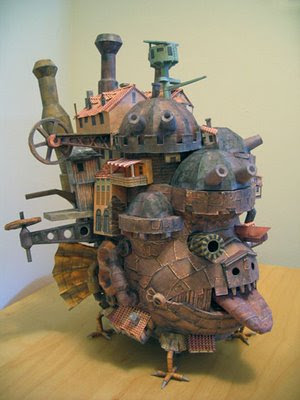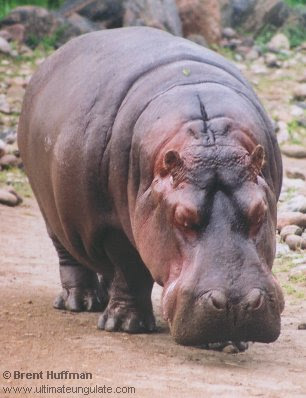You've probably seen Paul Moyse's work before, but just don't remember the name. The guy's brilliant!
Actually, this link will take you to the page on his web site where he put up caricatures of himself done by other artists. It's VERY instructive!

I thought it might be interesting to study some of these caricatures. Maybe they'll give us an insight into how far a caricature can deviate and still retain a likeness.
Let's start with the way Paul Moyse really looks. In the snapshot above his face appears to have two parts: a rounded, slightly squared-off top, and a weighty, imposing muzzle. The parts are unified by a big nose (Geez, I hope Moyse never reads this!).

Here's (above) Moyse's own caricature of himself. It's a great picture but, being a self-portrait, it attempts to flatter. The head is somewhat unified in design, and not so much in two distinct parts, as in the photo. A unified design is a sign of youth (I talk about this in my previous post on faces). The skin is also robust and tight, also a youthful characteristic. What the heck! When I do pictures of myself I always shave off a few years. That's an artists perogative.

Here's (above) another self-portrait. Wow! A terrific picture! It looks like something Virgil Parch might have drawn. You could say that the nose is too big and the eyes are too close, but it's so funny that it doesn't matter. Boy, if a drawing's funny, people accept it as an accurate caricature, even if it isn't.

Here's an interpretation of Moyse (above) by another artist, one that's more realistic (well, sort of). The eyes are just as close as in the previous picture but here they don't work. You forgive close eyes on a deliberately distorted picture, but on a more realistic picture like this, they seem out of place.

Another snapshot (above). Moyse's dome is round, but it's also squared off a little. The top of the head is de-emphasized and the wide-angle muzzle is thrust at the camera. .

Here's (above) a caricature by another artist that emphasizes the wide angle even more than the photo. The cheeks are less thick than his real cheeks, and the lips are bigger. You could argue that the top of the head might have been smaller, and more detail on the shirt might have been nice.

By another artist (above). The face has a puffy, bee-stung look to it, as if it's pushed out from the inside. The line work is beautiful, but the artist was so intent on capturing the puffy quality that he lost some of the likeness. As in the picture above this one, the dome seems to distract.
In general I think it's a mistake for a caricature to emphasize irregular puffiness, even if the subject really is puffy. I don't know why that is. It's a law laid down by Zeus, and we mortals would do best to follow it without question.
In a comment Niki mentioned that the puffiness makes the face look black. I never thought about it before, but I guess it does.


Here (above) the artist emphasizes the chin. Lots of artists do this, and I have to admit that the effect is appealing. It certainly helps in establishing volume and weight. Even so, it seems inappropriate to the subject.
Being a caricaturist can be scary. Sometimes you realize halfway through that you're starting to lose the likeness, but the drawing is succeeding on its own terms as a work of art, and it demands that you continue as before, subject be damned! You have no choice but to do that, but how do you justify it to the person you're drawing?
Wow! A highly-skilled picture (above) that emphasizes a just-woke-out-of-a-deep-sleep look in the subject's eyes. The technique is so wonderful that I hesitate to criticize, but Zeus compels me to remind artists that this quality of the eyes is forbidden to caricaturists. Only Zeus knows why, and he's not telling.
The hairy muzzle is given an emphasis that isn't in the photo reference, but it's done so well that you can't complain. The artist seems to be insinuating his own belief that facial hair is bizarre and unnatural, and I admire him for doing that.
Artists should insinuate their own opinions about the world into their work. That's because an artists first responsibility, even a caricaturists first responsibility, is to create a beautiful work of art that reveals something interesting about the natural world.
 Argghh! I thought I'd have this (above) science-fiction story up today, but I'm having Photoshop problems again. Will someone please tell me why layers that are supposed to be locked, unlock themselves and change names? The background layer (supposedly locked) becomes layer one, without me doing anything to it. Layer one looses its image and becomes transparent, even though I'm looking at it on the screen, and it's not transparent. AAAAAAARRRGGGHH!!!!!
Argghh! I thought I'd have this (above) science-fiction story up today, but I'm having Photoshop problems again. Will someone please tell me why layers that are supposed to be locked, unlock themselves and change names? The background layer (supposedly locked) becomes layer one, without me doing anything to it. Layer one looses its image and becomes transparent, even though I'm looking at it on the screen, and it's not transparent. AAAAAAARRRGGGHH!!!!!















































